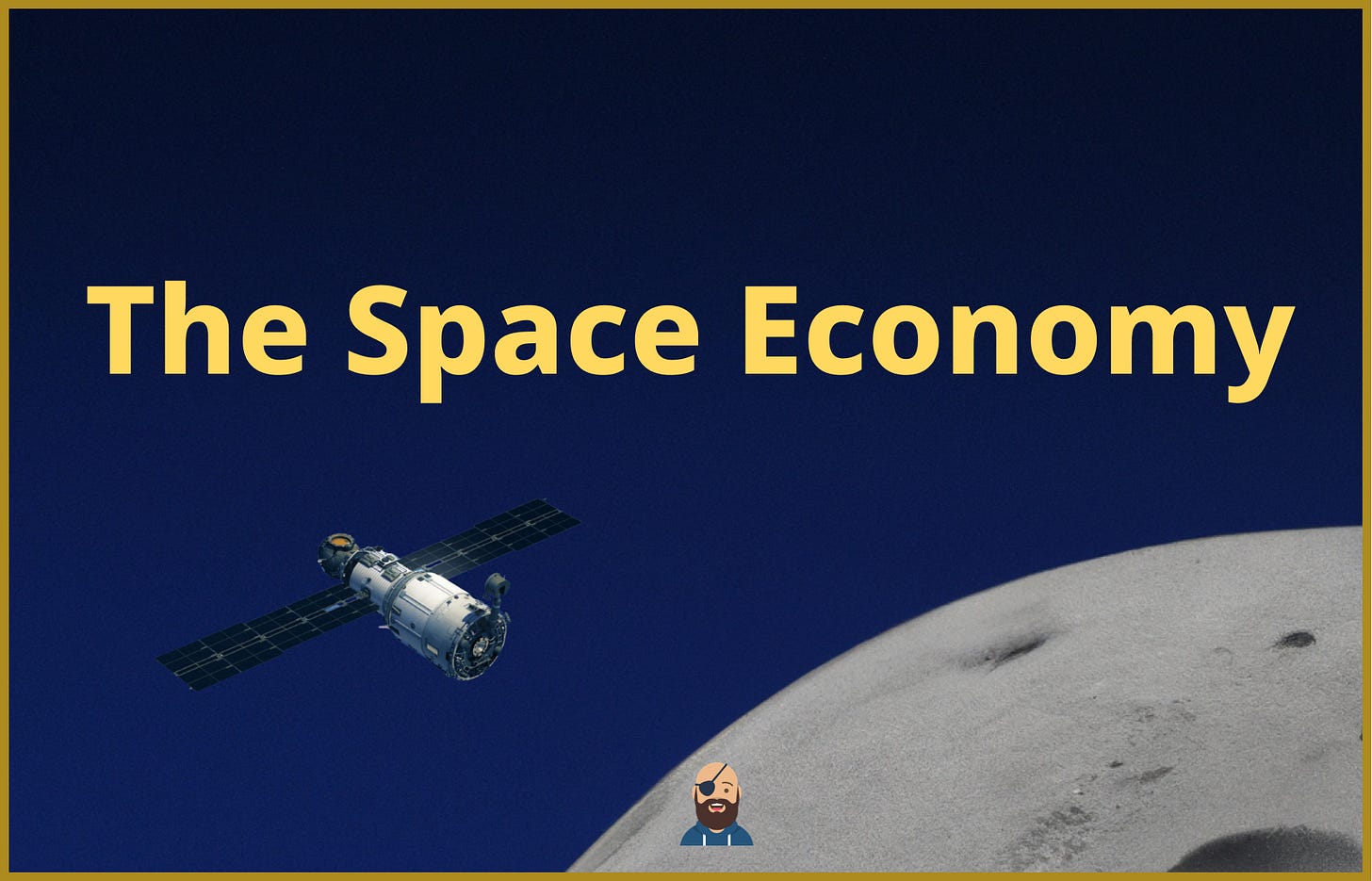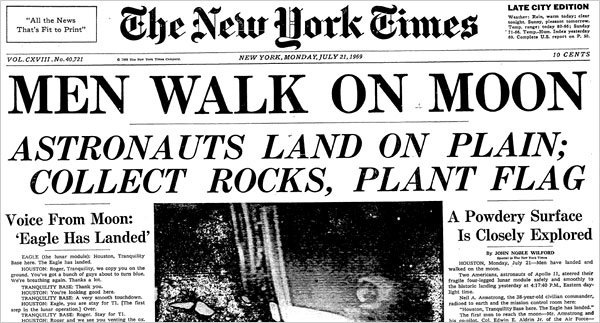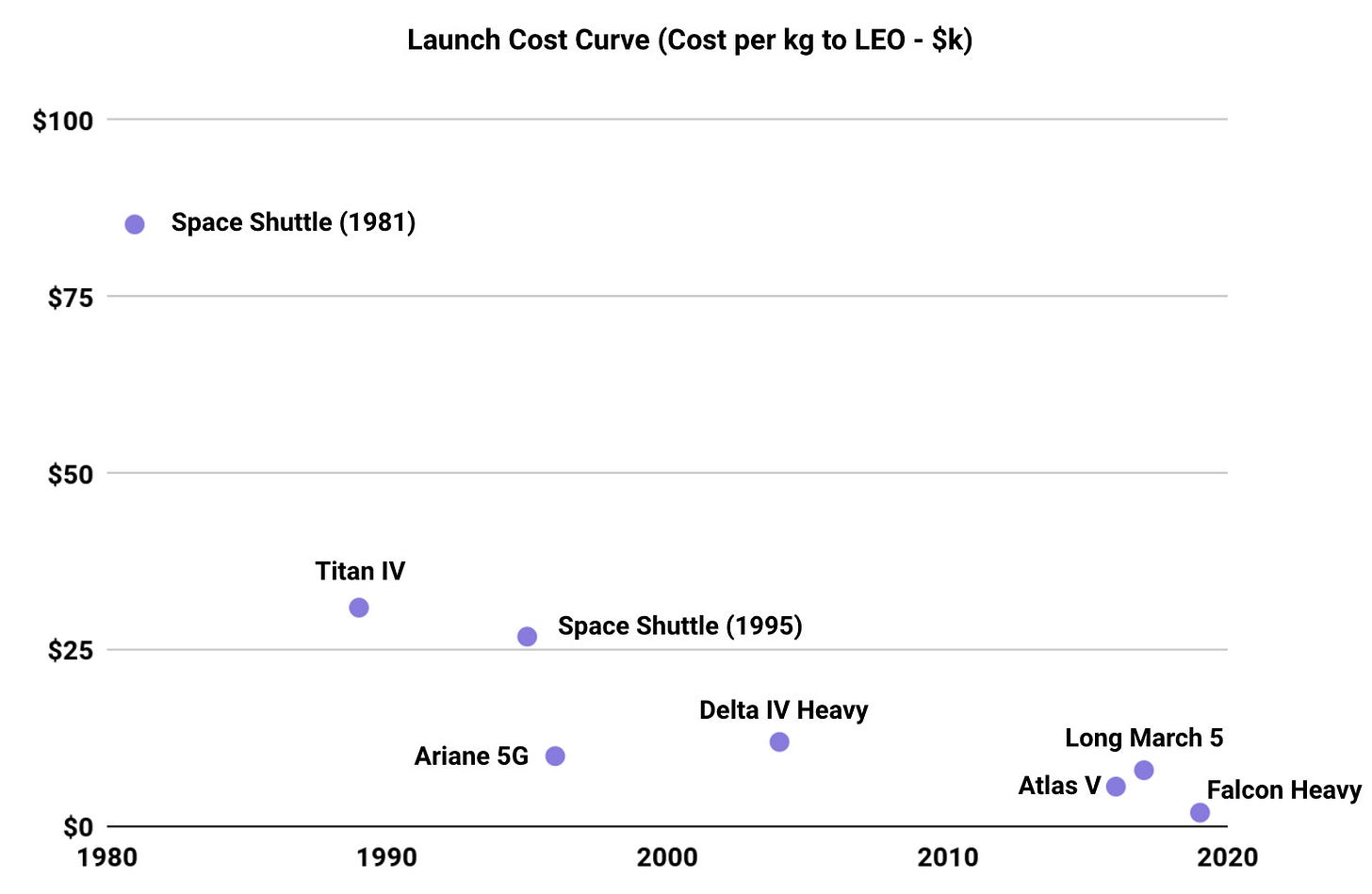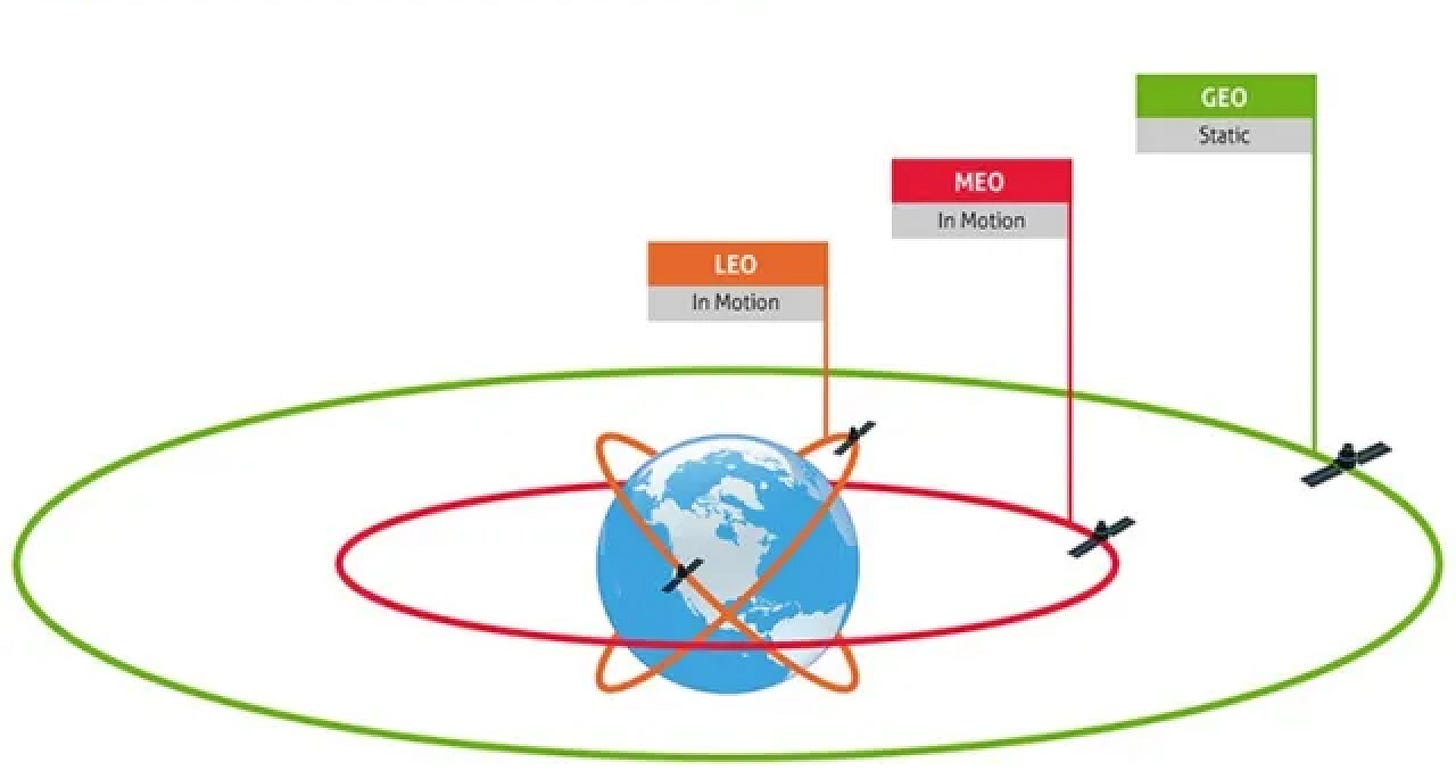The Space Economy
An introduction to space technology, scaling blockchains, Greek startups funding rounds & exits dashboard, building consumer products, jobs, events, and more
Welcome back to Startup Pirate, a newsletter about what matters in tech and startups — with a Greek twist. Come aboard and join 4,468 others. Still not a subscriber? Here’s what you recently missed:
Find me on LinkedIn or Twitter,
-Alex
The Space Economy
The space industry is at an inflection point. What was once monopolized by the world’s superpowers and leading space programs is now privatized, with companies taking the leadership mantle and a greater share of Earth’s orbit, rocket launches, and more. The growth of the space economy is jaw-dropping, as the number of objects launched into space has increased tenfold in the last decade.
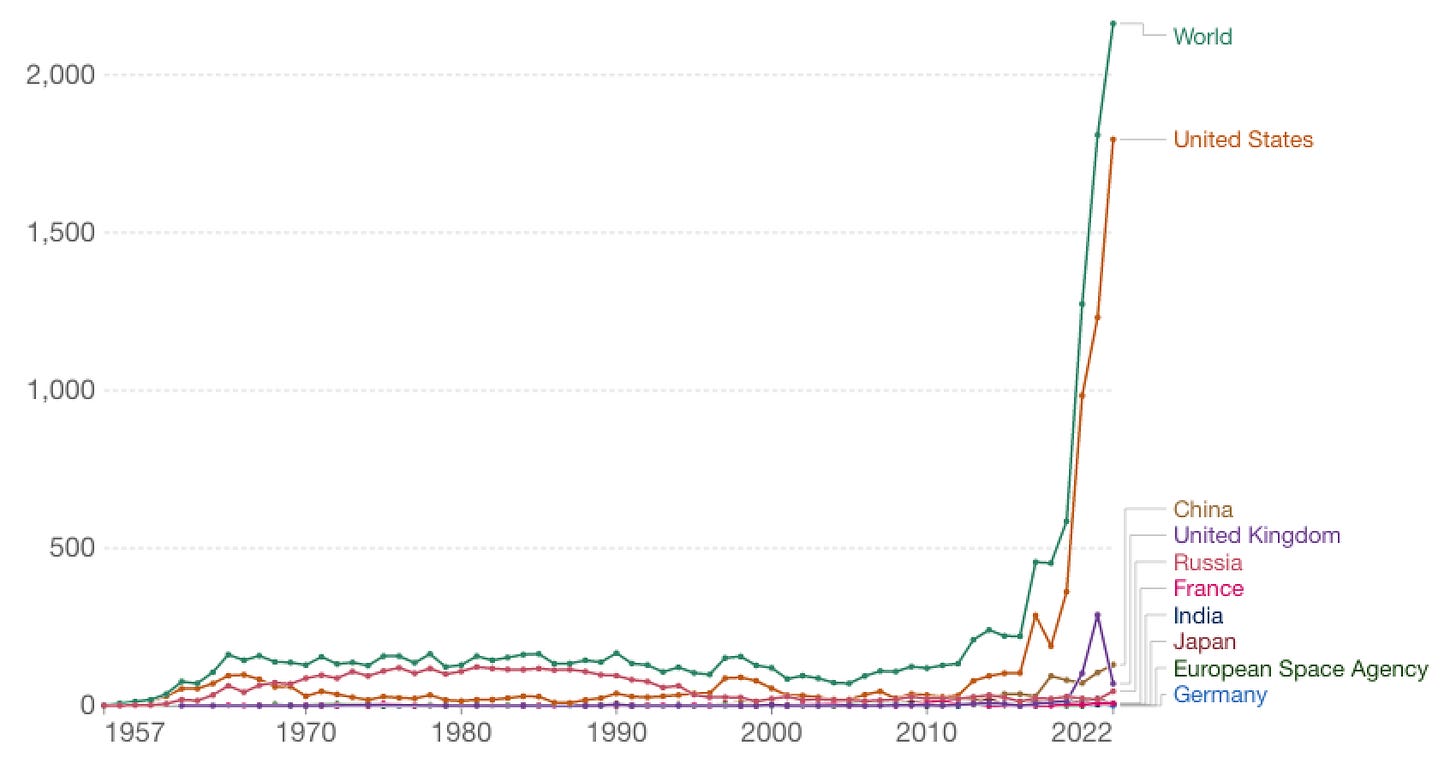
To learn more about the new space age and what enables it, I invited Manos Koumandakis, co-founder & Chief Architect of Infinite Orbits. Infinite Orbits is a space company which aims to unlock sustainability in space by extending the lifetime of some of the most valuable space assets — satellites.
Key insights we learn:
why space technology is important for humanity
what has led to the rise in rocket launches and the space economy booming
what makes satellites valuable space assets
space sustainability
the challenges of building a space tech company in 2023
Let’s get to it!
Mano, it’s good to talk to you! You founded a space tech company straight out of university, so before we get into our discussion, I got to ask: How does a university student become passionate about space?
MK: Honestly, I don’t know how a university student does not become passionate about space! Oh boy, I’ve been interested in space for as long as I can remember. I was even dreaming of becoming an astronaut when I was a kid. But as I grew older, the space industry didn’t click as a career path for me. Then, while I was a Computer Engineering student at Columbia University, we started a space club with some of my friends — something that was missing from Columbia’s extracurricular clubs. That’s how the Columbia Space initiative was born. Several club members went on to pursue a career at NASA and other leading space institutions after graduating. Being an active club member and interning at an aerospace company kind of pushed me over the board to build Infinite Orbits together with my talented co-founders.
We often see narratives propagated across the press and social media about the “billionaire space race” — Elon Musk’s SpaceX, Jeff Bezos’s Blue Origin, Richard Branson's Virgin Group — making it look like space is a contest for billionaires.
MK: Right; I think the way many of those things are portrayed and, consequently, how several people view the space industry are skewed. There might be real concerns, like questioning why billionaires fund space companies instead of helping solve more “earthly” problems: poverty, wars, etc. Space is pretty distant in most people’s minds.
But, this view is skewed, as there are many reasons why space is important for humanity nowadays. There are, of course, things such as advancing humanity’s understanding of the universe and space exploration, yet there are also immediate benefits:
Enabling telecommunications. Ask someone in Indonesia or some of the most remote places without cable TV or antennas whether they value satellite television. Or Ukrainians using Starlink’s satellite services as Russian attacks brought degradation of their telecommunications network.
Earth observation. There are multiple use cases enabled because we can observe the Earth from orbit. The agriculture industry has been transformed; for instance, we can more efficiently predict crop yields by observing elements, such as soil moisture, to help farmers support crop health. Despite the fact that there are more ways to observe the Earth, such as drones or aircrafts, satellite imagery is arguably the best way to do so at a global scale repetitively and continuously. The weather forecast industry, defence, and many other sectors have made leaps of progress due to satellite imagery.
Monitoring climate change. One of the main reasons we know about climate change is that we monitor it from satellites. To understand our changing Earth, we use remote-sensing satellites to observe it through multiple modalities. Satellites help us track greenhouse gas emissions, deforestation, sea level rise, melting polar ice caps, and more.
Navigation. GPS, or the Global Positioning System, and their non-US government equivalents e.g. EU's Galileo, are indispensable parts of global navigation. They provide critical positioning capabilities to military, civil, and commercial users worldwide.
Space is a huge industry, and it’s narrow-minded and misleading to focus on Musk and Bezos instead of the work of hundreds of thousands or millions of engineers and operators pushing the boundaries of the industry.
We’re going through a space economy boom. Despite the fact that NASA's budget sits an order of magnitude lower than its peak in the 1960s, commercial space activity has risen significantly. What do you think has enabled this?
MK: It’s not the first time we see activity and innovation in the space industry surging. There was the Space Race when the space programs of the US and Soviet Union kicked off a new front in the Cold War and one of the greatest technological showdowns of modern history. Launching the first satellites, sending astronauts to space, and then “landing a man on the Moon and returning him safely to Earth within a decade”, which became a national goal set for the US by President John F. Kennedy in 1961.
With the fall of the Soviet Union, the Space Race became a thing of the past, but space activity continued in the 1970s and 1980s when private companies began to launch communications satellites. All the big satellite operators were established then. And while space technology was accelerating outside the monopoly of the world’s superpowers and their leading space programs, we had the Space Shuttle Columbia disaster in 2003, which disintegrated as it reentered the atmosphere over Texas and Louisiana, killing all seven astronauts on board. This was the second Space Shuttle mission to end in disaster after the loss of Challenger and its crew in 1986. Since the first Space Shuttle disaster, NASA’s budget had declined and left an open space for commercial launchers.
What we see today is triggered by a significant drop in the launch cost. It has become so much easier to launch objects into space that we even see high school students building CubeSats (miniaturized satellites). I cannot stress how much fuel this has set to the whole space industry by inspiring generations after generations of people to go out there and experiment, tickling space nerds’ imaginations. On the contrary, in the 1980s, you’d only be able to do that if you had years of experience and deep pockets.
To a large extent, it’s SpaceX which changed the rules of the game and the fact that they manufactured reusable rockets, thereby reducing the cost of launch tremendously. Other companies followed suit, but you know, SpaceX does 60 launches/year, which is unheard of. This is true “rocket science”, and one can attribute this success to innovations in new materials, fuels, motors, engines, advances in software, etc. This wouldn’t have been possible previously. To be frank, there are a lot more spaceflight companies building interesting technologies right now. I’m optimistic that we’ll see even cheaper launches that will allow more and more people to experiment with space technologies.
Satellites drive a big part of space technology’s benefits for humanity and, therefore, a big part of the space economy. So let’s double-click here. What makes satellites valuable space assets, and which are their most important use cases?
MK: Historically, it’s been all telecom: consumer TV, radio, satellite phones. I think consumer TV has been 30% of satellite operators’ revenue. Nowadays, we have all these internet constellations launching, such as Starlink. Again, the ability to pump out so many satellites to offer internet services comparable to those at the ground level is something we couldn’t have in the 2000s. We touched upon this before — apart from telecommunications, there are more use cases for satellites, including earth observation, monitoring climate change, navigation.
Where I see a lot of innovation coming out of this field is satellite operators allowing other companies to spin businesses out of their infrastructures, sort of an Infrastructure as a Service model where they host other companies’ payload, software, etc. Instead of companies having to build their satellites and make in-orbit demonstrations, they “piggyback” on someone else’s satellite, where they can place cameras, thrusters, etc. This can propel innovation by creating new services built on existing space infrastructure, making it easier and cheaper to send payload into orbit.
Just to give a bit more context, satellites are comprised of the payload and the bus. The bus is all the subsystems used for any mission: telecommand and telemetry radios, batteries, solar panels, mechanical structure, etc. There’s also the payload, which transfers anything the mission was designed to send.
Last but not least, satellites can be found in three different Earth orbits: geostationary orbit (GEO), medium Earth orbit (MEO), and low Earth orbit (LEO). Satellites in all three orbit families bring in revenue, over 90% of which comes from GEO. A trend we are witnessing is that satellite revenue streams are slowly shifting towards the lower orbits. Launch costs there are lower, but usually, you can only provide the same quality of service with a large constellation of satellites.
Can you share more about Infinite Orbits and how Infinite Orbits fuels the space economy?
MK: Here’s the thing: we discussed how important satellites are for humanity’s understanding of Earth and outer space. The technology we build at Infinite Orbits and our services to satellite operators unlock space sustainability.
Let me explain this. Satellites are valuable real estate assets in space, right? But they suffer from failures, run out of fuel, collide with other space objects (space debris or trash, essentially, parts of other satellites), etc. There’s the Kessler syndrome effect which is a chain reaction of multiple satellites or parts of satellites colliding with other satellites and creating more trash. As we continue to have more launches every year, space debris will increase, and collisions will happen even more frequently.
So, in order to protect a satellite or extend its lifetime, we need space situational awareness, space surveillance, and satellite inspection. This means that the satellite can map other things in its orbit and identify their sizes, exact orbits, or other parameters that might be helpful. Space situational awareness is critical to safely navigate relative to other satellites and debris. Defence institutions are particularly interested in figuring out what other threats exist in space, as it’s relatively easy to attack another satellite in space. Moreover, satellite life extension and servicing are needed to add more fuel to the satellite or repair subsystems and, thus, delay their disposal.
At Infinite Orbits, we use new space technology and advanced tracking and navigation software to provide turnkey services to satellite operators. The company was founded in 2017 following a NASA challenge at Columbia University, and we have offices in France, Singapore, and Silicon Valley. With the technology we are building, we aim to address the above problems. To do that, we’re designing a way for satellites to navigate towards and safely dock with other satellites, the so-called “Rendez-vous and Docking”. The idea is to take a small satellite, in the class of 350-500 kilograms and dock it onto another satellite in orbit, one running out of fuel. Then, we transfer our satellite’s fuel to keep them in orbit. We also deal with failures in attitude control, which is responsible for controlling the orientation of a satellite. Our satellite can compensate for our client’s failures by utilizing our attitude control system. At the end of the lifetime extension period (five years), we can safely de-orbit the satellite and transfer it to the graveyard orbit, also called a junk orbit, that lies away from common operational orbits, to reduce the probability of colliding with operational spacecraft and generating space debris. We call this service Endurance, and we plan to have a GEO mission to demonstrate our technology in 2026.
Is this the first mission you’re planning?
MK: We have a GEO mission scheduled for the beginning of April 2023, OrbitGuard-1, and we will launch OrbitGuard-2 sometime in 2024 in collaboration with the space agency of Azerbaijan. OrbitGuard offers two kinds of services. Patented vision-based navigation allows our spacecraft to provide satellite inspection (get close to a satellite and visually inspect it), as well as space surveillance/SSA (identify threats and estimate their properties and orbits). It is essentially Endurance without the docking capabilities, just the rendez-vous ones. OrbitGuard-1 and OrbitGuard-2 are the first of four OrbitGuard missions planned in the next two to three years and will provide us with the experience necessary for the success of Endurance.
What are the challenges of building a space tech company in 2023?
MK: Despite what we’ve been discussing so far, that it has become easier to launch into space and the recent waves of innovation, it's still extremely difficult! We know this first-hand. We’ve been operating a space company for almost five years, and we're launching our first satellite now. It’s near impossible to test things out as a space company, doing multiple iterations and design cycles. It takes years to get to a point where you can manage a mission, especially a novel concept such as OrbitGuard or Endurance. Hence, you need to be creative in how you design the experiments. In other industries, you can spin an MVP up in a matter of months with a few software engineers. We need skilled engineers of all flavours and many collaborations with new and established space companies. At the same time, finding capital to build technology which requires long R&D cycles, is challenging as it involves hardware and supply chain risks and promises returns over a long horizon.
Before we wrap up, what are other recent developments in the space industry that you’re excited about?
MK: Autonomy and robotics have been propelling space tech innovation for decades. To be fair, robots have been part of the space program since the beginning. But they will unlock even more use cases in things like unmanned commercial space stations or massive satellite constellations. You know, there's not one person for every Starlink satellite because there are too many Starlink satellites operating.
Nowadays, there’s a “Henry Ford” moment in satellite manufacturing, with big factories manufacturing satellites much faster and cheaper than before. Building a satellite used to require over two years, whereas now it takes a few months.
There are also moonshot projects that I pay close attention to. Things like asteroid mining, which is the exploitation of materials from asteroids and other minor planets. Although it’s still in a very experimental phase, there’s the promise of transferring industrial activities into space, such as energy generation, one day.
Mano, thank you so much for taking the time. It was great to talk to you!
MK: Thanks Alex, it was a pleasure!
Startup Jobs
Looking for your next career move? Check out job openings from Greek startups hiring in Greece, abroad, and remotely.
News
MarineTraffic, the world’s leading provider of ship tracking and maritime intelligence, was acquired by Kpler, a data and analytics firm for commodity markets.
Blueground acquired Travelers Haven, a company providing on-demand housing with access to 20,000 US cities and $110m in revenue in 2022.
Car-as-a-service instacar announced a €55m Series A, including share capital increase and borrowing, by Autohellas, Elikonos Capital, Olympia Group and Velocity Partners.
Pandas raised funding from 5G Ventures and others to expand its omnichannel technology for trading phones and smart devices.
Decentralized gaming platform Ajuna Network raised $5m.
New investment rounds announced for Moverse (AI and optical sensing technology for human performance digitization), Agroverse (agriculture robots as a service), AidPlex (treatment and monitoring of orthopaedic patients) and BIO2CHP (raw organic waste to produce heat and electricity), led by TECS Capital Fund.
Orderit, a platform that simplifies the ordering process for restaurants and suppliers, raised a round led by Genesis Ventures.
New Products
Curating new product launches from Greeks in tech. Any launch is a fair game: startups, products, side projects. Hit me up with suggestions on what to include next.
Fileverse, SOTIRIA Technology, Shuttle Catheters, Crypto Analogy: Coin Stats, EnVsion
Interesting Reads & Podcasts
At Marathon, we launched the Greek Startups Funding Rounds & Exits dashboard. Trends on rounds and exits, with data updated as announcements get public — all in an interactive dashboard. (link)
Recording of the latest Open Coffee with Angelos Stavrakis (SafeSize), Dimitris Vassos (Omilia), Alex Tsilfidis & Elias Kokkinis (Accusonus). (link)
Thoughts on generative AI by Vassilis Tziokas, Global Lead, Web3 Business Development & Strategy at Microsoft. (link)
Lessons learned building a consumer product with Mark Tsirekas, VP Product at ZOE. (link)
Managing managers by Zaharenia Atzitzikaki, Design leader & executive coach. (link)
Introduction to scaling blockchains by Stelios Gerogiannakis, Senior Engineering Manager at Ignite. (link)
It's time to move on from hoarding raw consumer data by Georgios Depastas, co-founder & CEO at Lerna AI. (link)
Making the iOS community more inclusive with Eleni Papanikolopoulou, iOS Engineer at Skroutz. (link)
On tech debt by Kostis Gkiokas, Senior Engineering Manager at Timescale. (link)
Events
“Kubernetes Athens vol18” by Athens Kubernetes Meetup on Mar 2
“Global AI bootcamp” by Thessaloniki .NET Meetup on Mar 4
“Building Performance Test Framework with k6 and Typescript” by Athens SDET Meetup Group on Mar 6
“35o Bitcoin/Blockchain Meetup” by Bitcoin & Blockchain Tech Meetup (Thessaloniki) on Mar 8
If you’re new to Startup Pirate, you can subscribe below.
Thanks for reading, and see you in two weeks!
P.S. if you’re enjoying this newsletter, share it with some friends or drop a like by clicking the buttons below ⤵️

